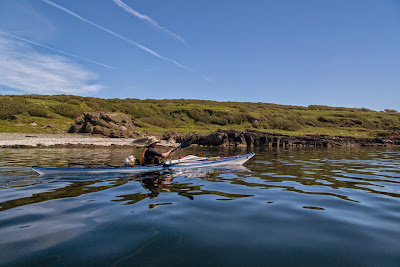...we needed to keep a sharp eye out for other vessels such as FV Five Sisters (OB 353) from Campbeltown (from where we had set off on our adventure 6 days previously.
In the calm conditions my injured shoulder was really feeling the strain as we had to drop the sails. The others were soon far ahead but...
...I caught up as they waited for the bulk carrier CSL Clyde to pass on her way north to Hunterston ore terminal.
At long last we approached Portencross Castle and made our way round Farland Head, upon which it stands, to the sheltered...
...pink sands of Ardneil Bay. It was time for a celebration! We had set foot on Ayrshire for the first time since we had bought single tickets for Campbeltown and left its shores six days previously on the ferry MV Isle of Arran. Mind you it was a pretty watery celebration. We had run out of Guinness earlier in the trip and...
...had to resupply in Tarbert some 40 km away, far to the north of the distant Isle of Arran. Unfortunately the Co-op store only sold a pale yellow liquid...
...called S***l*. We thought it was mislabeled P**h, but at least it was wet and we were very thirsty.














































